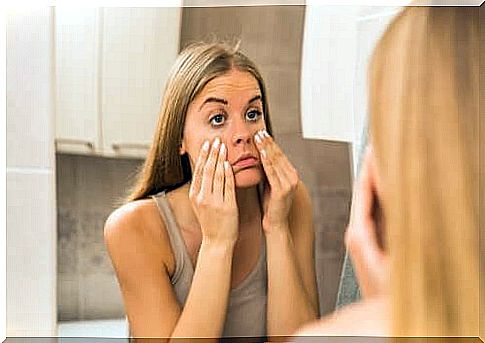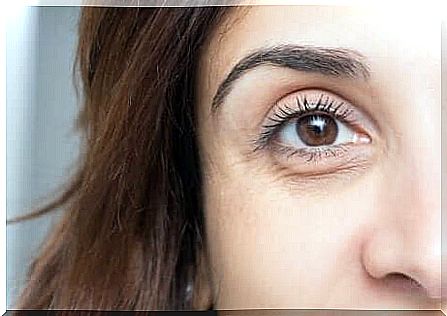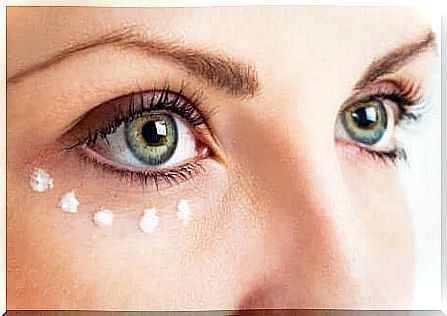Why Do Dark Circles Appear?
The causes of the appearance of dark circles are generally diverse. In addition, certain habits or health conditions accelerate their appearance.

When dark circles appear, people automatically associate them with a bad night’s sleep. Even though this is one of the most common causes of this dark coloring around the eyes, you should know that it is not the only reason.
Also, the idea that a person has dark circles because they are sick is quite common. While it is true that a sick person often has this mark on their face, healthy people can also experience dark circles.
However, they are only rarely linked to a major health problem. So the question is… Why do dark circles appear? There are several answers to this question.
What are dark circles?
Dark circles are a bluish, gray, or purple color that appears under the lower lids of the eyes. The most common is that this only happens once in a while; however, some people frequently have dark circles … even without being sick or having slept well.
If dark circles come out under the lower eyelid, it is because this area of the skin is quite thin and sensitive. It is barely half a millimeter thick, which means that it is 5 times thinner than the skin on the rest of the face and 10 times thinner than that of the rest of the body.
Likewise, under the lower eyelids, there is less collagen and this area distends more easily due to blinking. All this makes the tone of the blood vessels more transparent than in other areas of the body.

Puffiness and dark circles
Bags under the eyes and dark circles are two problems that are similar but not the same. They are often confused because they appear in the same place: the lower eyelid of the eye. Nevertheless, they have a different nature and obey different causes, although they can sometimes arise simultaneously.
Dark circles, as already reported, correspond to an increase in the pigmentation of the eyelid area. In this line of idea, a study published by the International Journal of Dermatology distinguishes three types of dark circles:
- Pigmented. They are linked to an increase in melanin in the eyelids.
- Vascular. The blood vessels in the eyelid area become transparent.
- Periorbital swelling. In this case, there is a marked groove that runs from the inner corner of the eye to the cheek.
Puffiness, on the other hand, is an inflammation or protrusion that appears under the lower eyelid. As such, they have no particular coloration and arise due to loss of muscle tone in the eyelid, build-up of fluids, or protrusion of orbital fat in the eye.
Why do dark circles appear?
One of the reasons dark circles appear is genetic. In this case, the eyelid area is more pigmented and it is a trait that is inherited. Moreover, certain ethnic groups may have a greater tendency to present them.
Causes of their appearance
- Tired. It is one of the most common causes. Fatigue causes blood vessels to dilate and the delicate skin of the eyelid reflects this more clearly (even more so if fatigue is accompanied by stress).
- Medicines. Some hypotensive eye drops (that is, lowering intraocular pressure) cause pigmentation to appear around the eye.
- Unbalanced diet. Excessive consumption of salt or foods with caffeine, especially at night, leads to fluid retention and affects the appearance of dark circles.
- Sunlight. The lower eyelids are sensitive to solar damage. Excessive exposure activates the production of melanin and dark circles appear.

Other causes
- Allergic reaction to a cosmetic. When the skin cannot tolerate a certain cosmetic, it can generate reactions such as dark circles. This happens with products like correctors or delineaters.
- Other allergies. Allergies lead to greater segregation of histamines and these, in turn, lead to vascular dilation. In addition, if the eyes itch and if they are rubbed vigorously or frequently, it is possible to see dark circles appear.
- Fluid retention. Fluid retention is one of the causes of the appearance of dark circles, in addition to bags under the eyes.
- Hormonal changes. Hormonal changes are not a direct cause of the appearance of dark circles, but they generate organic changes that affect the pigmentation of the eyelid; like retention of fluids.
- Aging. As the years pass, the skin of the eyelid becomes thinner and more transparent.
- Other causes. The lack of iron, atopic dermatitis, eczema and the reduction of fat around the eyes are also causes of the appearance of dark circles.
Accept them
The reasons why dark circles appear are varied and may be different in each person. However, they usually do not indicate serious health problems (except when they are the result of fluid retention or illness).
In general, strengthening cosmetic treatments can help alleviate them. However, the expert José María Rumbo-Prieto indicates that the ideal would be to learn to accept them. Moreover, the definitive solution to carry out any modification consists in undergoing a pigmentation treatment. Therefore, consult a specialist to find out more about it.









